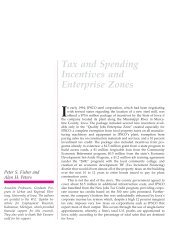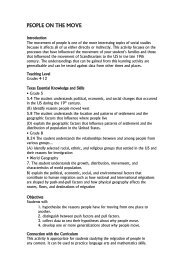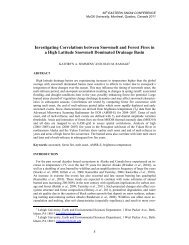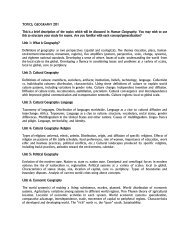Texas Social Studies Framework - Department of Geography ...
Texas Social Studies Framework - Department of Geography ...
Texas Social Studies Framework - Department of Geography ...
You also want an ePaper? Increase the reach of your titles
YUMPU automatically turns print PDFs into web optimized ePapers that Google loves.
Chapter 5: The Teaching-Learning System: Curriculum, Instruction, and Assessment<br />
EXAMPLES OF INSTRUCTIONAL STRATEGIES<br />
Following is a selective guide to instructional strategies.<br />
Each <strong>of</strong> these incorporates several models <strong>of</strong> instruction.<br />
For more details and information see the SSCED website<br />
at <br />
Teaching Concepts<br />
GENERALITY<br />
Concepts are building blocks; they link facts and generalizations.<br />
In order to understand a generalization,<br />
students first must understand its component concepts.<br />
Consider this important social studies generalization:<br />
refugees migrate due to push forces. The student<br />
who does not know the meaning <strong>of</strong> two concepts,<br />
refugees and push forces, cannot understand the<br />
generalization.<br />
Research has identified this general instructional strategy<br />
to be effective in teaching concepts. Teachers direct the<br />
activity initially, but students can apply the strategy as<br />
they move from learning to developing concepts.<br />
Figure 21: The Structure <strong>of</strong> Knowledge<br />
1) Identify examples and non-examples illustrating<br />
the concept and place them in a logical order.<br />
One <strong>of</strong> these examples is identified as the<br />
“model.” The model includes all the key attributes<br />
<strong>of</strong> the concept.<br />
2) Develop materials or oral instructions with a set<br />
<strong>of</strong> cues, directions, questions, and student<br />
activities that draw attention to the critical<br />
THEORY<br />
PRINCIPLES<br />
GENERALIZATIONS<br />
CONCEPTS<br />
FACTS<br />
SPECIFITY<br />
attributes, similarities, and differences in the<br />
examples and non-examples used to define the<br />
concept.<br />
3) Focus student attention on the model. What are<br />
its attributes and characteristics?<br />
4) Ask students to compare all the examples with<br />
the model, or best example.<br />
5) Ask students to develop a definition <strong>of</strong> the<br />
concept or state it for them.<br />
6) Place the concept in relation to other student<br />
knowledge; try to attach this information to<br />
existing student knowledge structures (schema).<br />
7) Give students examples and non-examples to<br />
assess whether students understand the concept.<br />
Ask students to generate additional examples or<br />
apply the concept to new situations.<br />
Figure 22 shows how teachers can develop a lesson to<br />
help students understand the concept “refugee.”<br />
Teaching Generalizations<br />
47<br />
47<br />
There are two ways to organize instruction to help<br />
students develop generalizations, the inductive (discovery)<br />
approach and the deductive (expository) approach.<br />
The inductive approach is related to inquiry learning.<br />
Students examine sets <strong>of</strong> data and materials. With the<br />
teacher they identify and explain key points, observe<br />
similarities and differences, patterns, and trends. Finally,<br />
students draw conclusions from the data, summarize their<br />
findings, and infer a generalization.
















